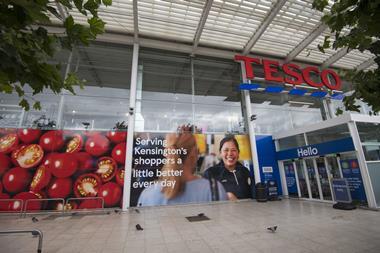The Japanese have a saying: “The misfortune of others tastes like honey.” And Sainsbury’s is hoping that sweet, sweet stuff will fuel its new loyalty scheme.
The supermarket today launched Nectar Prices, which gives cardholders access to lower prices on products in physical stores or online. And, crucially, knowledge of the far higher prices those without membership will be doomed to shell out. Yum.
More than 300 products are initially included in the scheme, which will later expand to more SKUs and more categories. As Sainsbury’s puts it: “This is just the start.”
If that all sounds a lot like Tesco’s Clubcard Prices, that’s because it is. And why shouldn’t Sainsbury’s copy a good thing?
Latest figures from Tesco show a Clubcard is used for 84% of sales across all Tesco UK stores. Tesco has managed to add three million active Clubcard-holding households to the scheme in the past year, thanks in part to a major marketing campaign.
The Clubcard app has more than trebled its reach year on year to 1.8 million people. Customer satisfaction is strong: 3.82 out of 5 according to Moneyboat.co.uk, versus Nectar’s 2.58 out of 5.
Nectar isn’t doing too badly itself, with a membership of some 18 million customers. But its latest move shows how the concept of loyalty is evolving.
Loyalty schemes used to titillate the food shop faithful with some pennies off their shop, or tantalise them with the future joy of a cheap cinema date, meal out, or Eurostar trip to Paris. If only they could amass enough of those ephemeral points. Those distant dreams of a cut-price Pizza Express meal, say, kept customers coming back and giving up their data.
Now these schemes are looking to give shoppers a far more instant and satisfying boost: smug schadenfreude right there in the aisle. A trip around a Tesco raises a smile in every aisle as customers see what they might have paid for their purchases if they were foolish enough – and in a cost of living crisis too! – not to be a card carrier.
The Clubcard-less, meanwhile, are made to wince and squirm at the acute pain of paying ‘full price’ for everyday items. Morrisons and Boots are pursuing similar strategies.
The initial aim of the retailers – to amass customer data – remains the same. But their approach to loyalty has become less flirty (come see the shiny prizes) and more forceful (don’t be a mug and pay mug’s prices).
It’s not without risk. Shelf-edge displays of why you might not want to shop at a store could well turn people off. Many shoppers may resent the need to share their data to bag affordable prices.
But this is the clever part. Unless that resentment runs particularly deep – to the point where they would rather pay more or shop elsewhere altogether – they’re still likely to buy into the proposition. These days, there is little point stepping foot in a Tesco store without a Clubcard, unless you relish the suffering of not saving.
Sainsbury’s is headed in a similar direction. In one particularly striking example, the shelf price of a 200g jar of Nescafé Gold Blend instant coffee will drop from £8.10 to £4 for cardholders. Who would want to pay more than double?
Whether this will help Sainsbury’s in terms of gaining share, though, will depend on how competitive these discounted prices really are in a wider context. After all, the discounters are continuing to nab shoppers thanks to their attractive everyday low prices. Aldi increased its market share from 8.6% to 9.9% year on year in the 12-week period to the end of March, while Lidl grew share from 6.4% to 7.4% [Kantar]. At the same time, Sainsbury’s and Tesco are losing share.
So Sainsbury’s new scheme will only hold appeal if the cardholder prices are significantly better than beforehand, and capable of giving Aldi and Lidl a run for their money. If this is simply a case of elevating prices for non-cardholders to make discounts look more attractive, shoppers will quickly spot the ruse.
After all, if there’s one thing that’s guaranteed to take the sweetness away from a discount, it’s the bitterness of feeling manipulated.




















No comments yet